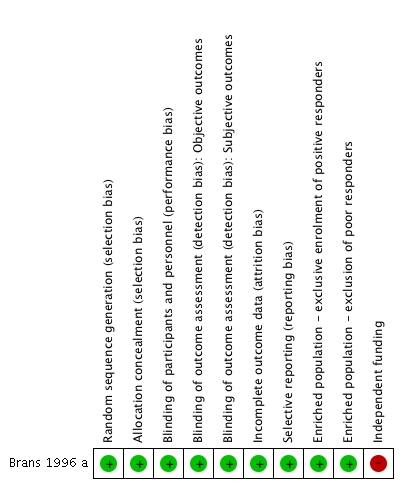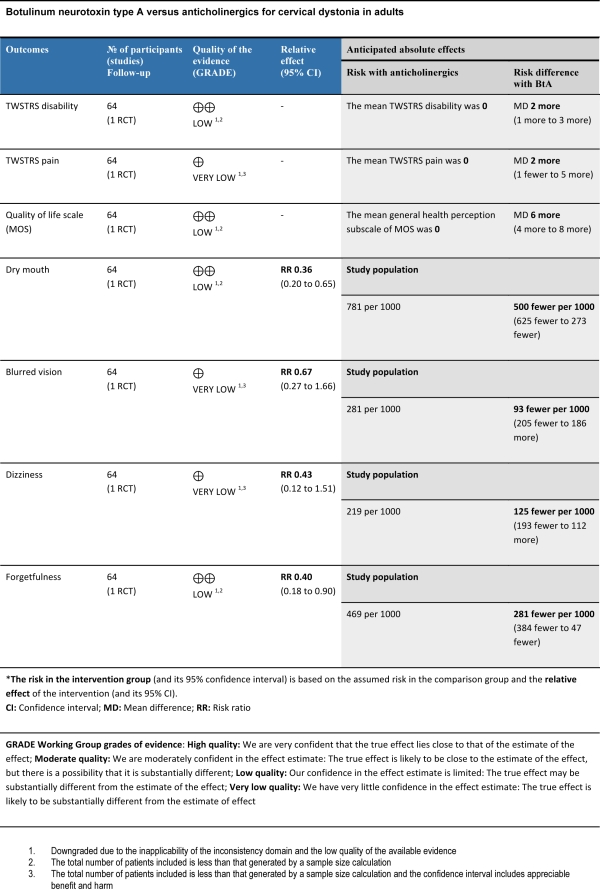Session Information
Date: Thursday, June 23, 2016
Session Title: Dystonia
Session Time: 12:00pm-1:30pm
Location: Exhibit Hall located in Hall B, Level 2
Objective: To compare the effects of botulinum toxin A (BtA) versus anticholinergics in adults with cervical dystonia (CD).
Background: This is an update of a Cochrane systematic review (Costa 2005). CD is a disabling disorder characterized by involuntary head posturing and is the most frequent type of dystonia. BtA is now the first line therapy. Before BtA, anticholinergics were the most widely accepted treatment, being important to evaluate how these two treatments compare.
Methods: Search: Cochrane Movement Disorders Group register, CENTRAL, MEDLINE, EMBASE, reference lists and conference proceedings, last run in December 2015. Selection criteria: double-blind, parallel, randomized, placebo-controlled trials of BtA versus anticholinergics in adult patients with CD. Data collection: two independent authors assessed records, selected included studies, extracted data and evaluated the risk of bias. Disagreements were solved by consensus or by a third element.
Results: We included one study (n=66) with a low risk of bias.  This study compared BtA to trihexyphenidyl. BtA-treated patients showed a small improvement in TWSTRS-disability (MD 2, 95%CI 1 to 3) and –pain (MD 2, 95%CI -1 to 5) subscales, comparing with the trihexyphenidyl arm. No data was available for severity subscale or overall TWSTRS score. There was a significant difference in quality of life measurements favoring BtA (MD 6, 95%CI 4 to 8). The absolute frequency of adverse events was lower among BtA-treated patients (p<0.0001). The most frequent adverse events were dry mouth (RR 0.36, 95%CI 0.20 to 0.65), blurred vision (RR 0.67, 95%CI 0.27 to 1.66), dizziness (RR 0.43, 95%CI 0.12 to 1.51) and forgetfulness (RR 0.40, 95%CI: 0.18, 0.90).
This study compared BtA to trihexyphenidyl. BtA-treated patients showed a small improvement in TWSTRS-disability (MD 2, 95%CI 1 to 3) and –pain (MD 2, 95%CI -1 to 5) subscales, comparing with the trihexyphenidyl arm. No data was available for severity subscale or overall TWSTRS score. There was a significant difference in quality of life measurements favoring BtA (MD 6, 95%CI 4 to 8). The absolute frequency of adverse events was lower among BtA-treated patients (p<0.0001). The most frequent adverse events were dry mouth (RR 0.36, 95%CI 0.20 to 0.65), blurred vision (RR 0.67, 95%CI 0.27 to 1.66), dizziness (RR 0.43, 95%CI 0.12 to 1.51) and forgetfulness (RR 0.40, 95%CI: 0.18, 0.90).
Conclusions: Very low to low quality evidence showed BtA has a better safety and efficacy profile than trihexyphenidyl.  The findings of this update provide the best evidence currently available comparing BtA to anticholinergic drugs, but the small sample size, among other methodological bias, preclude us from further recommendations.
The findings of this update provide the best evidence currently available comparing BtA to anticholinergic drugs, but the small sample size, among other methodological bias, preclude us from further recommendations.
Costa J, Espírito-Santo CC, Borges AA, Moore P, Ferreira J, Coelho MM, Sampaio C, Rodrigues F, Duarte G, Marques AR, Castelão M. Botulinum toxin type A versus anticholinergics for cervical dystonia. Cochrane Database of Systematic Reviews 2005, Issue 1. Art. No.: CD004312. DOI: 10.1002/14651858.CD004312.pub2.
To cite this abstract in AMA style:
F.B. Rodrigues, G.S. Duarte, R.E. Marques, M. Castelão, J.J. Ferreira, P. Moore, J. Costa. Botulinum neurotoxin type A versus anticholinergics for cervical dystonia in adults – 2016 Cochrane movement disorders group systematic review update [abstract]. Mov Disord. 2016; 31 (suppl 2). https://www.mdsabstracts.org/abstract/botulinum-neurotoxin-type-a-versus-anticholinergics-for-cervical-dystonia-in-adults-2016-cochrane-movement-disorders-group-systematic-review-update/. Accessed December 24, 2025.« Back to 2016 International Congress
MDS Abstracts - https://www.mdsabstracts.org/abstract/botulinum-neurotoxin-type-a-versus-anticholinergics-for-cervical-dystonia-in-adults-2016-cochrane-movement-disorders-group-systematic-review-update/
